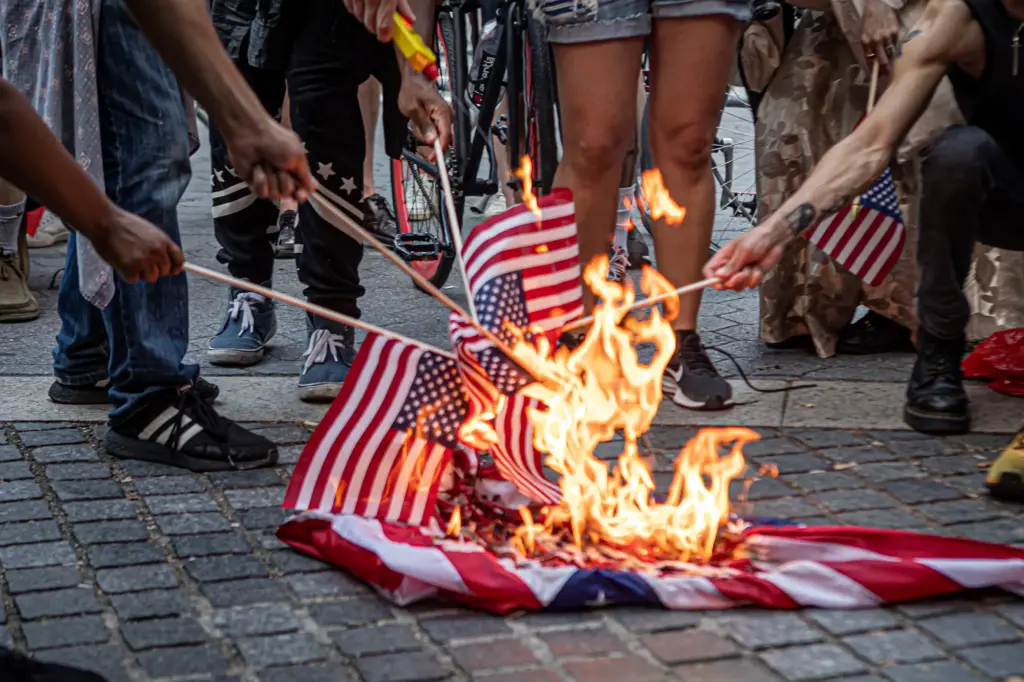Your cart is currently empty!

The Environmental Impact of Burning U.S. Flags: And Safer Alternatives
The Flag of the United States holds a profound symbolic meaning, representing freedom, unity, and the ideals upon which the nation was founded. However, for some, burning the flag has become a form of protest, a stark and powerful expression of dissent. While burning the U.S. flag is protected under the First Amendment as a form of free speech, there are environmental and health concerns associated with burning modern synthetic flags that many may not be aware of.

The Environmental Concerns
Most U.S. flags found in residential areas are made from synthetic materials such as nylon or polyester. When these materials are burned, they release a host of harmful chemicals into the air, including:
- Hydrogen cyanide: A highly toxic gas that can be harmful or even deadly when inhaled.
- Dioxins and furans: Persistent organic pollutants that are highly toxic and can cause reproductive and developmental problems, damage the immune system, interfere with hormones, and also cause cancer.
- Heavy metals: Depending on the dyes and treatments used in the flag, burning can release heavy metals like lead and cadmium, which are dangerous pollutants.
These chemicals not only pose a direct health risk to individuals nearby but also contribute to air pollution, negatively impacting the environment.

A Safer Alternative: Burning the Flag in Effigy
To express one’s views without harming the environment, consider printing an image of the flag onto plain printer paper and burning that instead. Printer paper is generally made from natural fibers like wood pulp, and when burned, it releases significantly fewer harmful chemicals compared to synthetic flags. This approach maintains the symbolic act of protest while minimizing environmental damage.

A Pyrotechnic Alternative: Enhanced Cotton Flag Burn
For those looking for a more dramatic or pyrotechnic effect, consider using a cotton U.S. flag treated with a simple chemical solution to make it burn quickly and efficiently, similar to how fireworks are designed to burn brightly without harming the environment excessively.
Materials Needed:
- A cotton U.S. flag
- Potassium nitrate (commonly available as a stump remover)
- Granulated sugar
- Water
- A large container for soaking
Recipe:
- Prepare the Solution: In a large container, mix a solution of potassium nitrate and sugar in a 3:2 ratio by weight. For example, use 300 grams of potassium nitrate and 200 grams of sugar.
- Dissolve in Water: Add warm water to the container and stir until the potassium nitrate and sugar are fully dissolved. The amount of water should be enough to completely submerge the flag.
- Soak the Flag: Place the cotton flag into the solution, ensuring it is fully submerged. Allow it to soak for several hours to ensure the fibers absorb the solution thoroughly.
- Evaporate the Water: Carefully remove the flag from the solution and lay it out flat in a well-ventilated area to dry. You can use a low heat source, such as placing it in the sun or using a fan. The goal is to evaporate the water, leaving behind a coating of potassium nitrate and sugar in the flag fibers.
- Burn the Flag: Once dry, the flag is ready to be burned. The potassium nitrate acts as an oxidizer, allowing the flag to burn quickly and with minimal smoke, producing a bright flame. This effect is somewhat opposite of flame retardant treatments and adds a pyrotechnic element to the act of protest.
When burning flags, especially when enhanced with added combustibles like potassium nitrate and sugar, safety should be a top priority. Always conduct the burn in a well-ventilated outdoor area, away from buildings, flammable materials, and dry vegetation. Wear protective gloves and safety goggles to shield yourself from heat and potential sparks. Have a fire extinguisher, water source, or sand nearby in case the fire becomes unmanageable. Never leave the burn unattended, and keep children and pets at a safe distance. Ensure that the flag is completely extinguished before leaving the area, and dispose of any remnants responsibly. Following these precautions will help prevent accidents and minimize environmental impact while allowing for a safe expression of protest.
Conclusion
While the act of burning the U.S. flag is a legally protected form of expression, it is essential to consider the environmental implications of burning synthetic materials. By opting to burn a paper representation or a treated cotton flag, individuals can still make their symbolic statement without releasing harmful chemicals into the environment. These alternatives uphold the freedom of expression while demonstrating responsibility towards the health of our communities and the planet.
